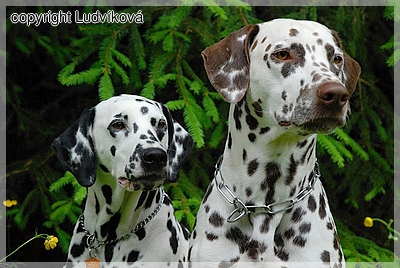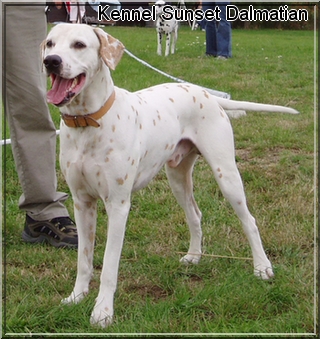
Dalmatian dog
Dalmatian dog
The Dalmatian dog belongs to the oldest known breeds of dogs and it is said that its appearance has almost not changed over time. The Dalmatians even occur on ancient Egyptian paintings. Similarly as in a number of other breeds, the cynologists cannot agree on the roots of this spotted beauty. Most probably it comes from the Mediterranean region of Dalmatia, today's Croatia. In the Victorian era, the Dalmatian became a very popular breed as a coach or carriage dog, because they were formerly used to run in attendance of a coach and lived in stables together with horses.
.
Colouring
.

.
Dalmatian puppies are born white and develop spots gradually within several weeks. The basic colour is white with black or brown spots. According to FCI-standard, the spots should be round, well defined, must be separate and uniformly spread with a diameter of 2 to 3 cm. The spots on head, tail and extremity ends can be smaller than the spots on the body. In Dalmatians, lemon coloured spots may occur, for which the locus E is responsible. However, this is a non-standard and relatively rare colour.
.
Coat colour genetics in Dalmatian dogs
In Dalmatians, it is recommended testing the E locus and B locus.
Dalmatian with black spots:
|
Genotype |
Color spots / Nose color |
Transmission of coat color |
|
EEBB |
black / black |
- |
|
EeBB |
black / black |
lemon |
|
EEBb |
black / black |
brown |
|
EeBb |
black / black |
lemon, brown |
Dalmatian with brown spots:
|
Genotype |
Color spots / Nose color |
Transmission of coat color |
|
EEbb |
brown / brown |
- |
|
Eebb |
brown / brown |
lemon |
Dalmatian with lemon spots:
|
Genotype |
Color spots / Nose color |
Transmission of coat color |
|
eeBB |
lemon / black |
- |
|
eeBb |
lemon / black |
brown |
|
eebb |
lemon / brown |
- |
.
Example of a lemon Dalmatian:

.
As a matter of interest, we state other spotting colours that might rarely occur in Dalmatian dogs. These colours are like the lemon colour considered as disqualifying feature and present a significant deviation from the standard.
- Dalmatian with markings has on the head, neck, chest, legs or tail (in places, where the marking is common in other breeds) additional light brown spots. The spot fading and normal processes of coat changes caused by the environment cannot be considered as marking. For the marking the locus A is responsible.
- Besides the lemon coloured spots, the Dalmatians can also have orange (falls somewhere in between that of dark lemon and brown), blue or grey spots. The orange Dalmatians can have black or brown noses - the black nose is more frequent, making it easier to differentiate from a brown Dalmatian with a brown nose. The shift to the lighter colours (grey, blue, orange) is caused by locus D.
- Further interesting dog is the brindle Dalmatian, in which the spots run into one another and create larger spots with a pattern of dark stripes on a fawn coloured background. The brindle pattern is caused by the locus K.
- Sometimes a litter of purebred Dalmatians includes one with a longhaired coat. Such Dalmatians have longer hair on ears, chest and fore chest and a bushy tail.



